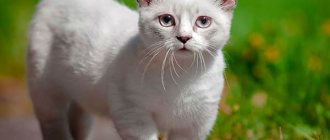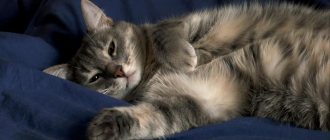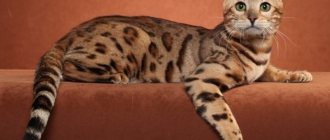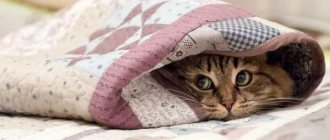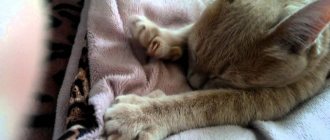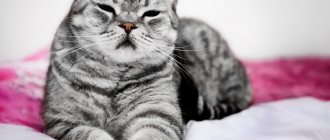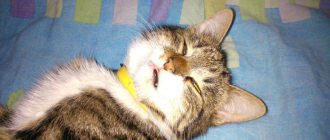Origin story
The origin story of the dwarf cat, whose name mentions a world-famous commander, is simple and uncomplicated.
On a warm June day in 1995, breeder Joseph Smith read an article in the morning newspaper about surprisingly cute munchkin cats. He was so delighted with these tiny short-legged fluffies that he set himself the goal of improving the breed as much as possible. And he succeeded, despite the fact that until that time he had worked exclusively with dogs (the appearance of the Basset Hound breed was solely his merit). As a second participant in the process, Smith decided to involve the Persian breed, no less cute and fluffy than munchkins.
The first attempts suffered a crushing failure: the representatives of the new breed turned out to be beautiful, adopted the best features from their parents (from the Persians - a slightly flattened muzzle and soft shiny fur, from the Munchkins - miniature stature and tiny paws), but they could not boast of good health.
Multiple genetic defects led to cats dying at an early age, and getting an absolutely healthy animal was both difficult and expensive. Therefore, felinological organizations (except TICA) initially refused to register the new breed.
Smith was so upset that he gave up work and burned all his notes. However, there were others who took up the baton. Terry Harris, Margie Gardner and Sam Tate, full of enthusiasm, achieved what they wanted. The breed received another name – Minuet Cat, which means “small”. The new breed was approved, but with a caveat - the name “Napoleon” may offend the national pride of the French, so it is better not to use it.
Genet
Genetta breed history: Actually, the Genet is a small African predator from the viverrid family, relatives of the felines. Today, genets are domesticated and kept as pets. However, the genet is a wild animal, and that is why the idea was born in the minds of American felinologists to create a breed of domestic cats similar to the genet. And this breed was created in Texas in 2008 by Powstrak nursery specialist Shannon Kiley. When breeding genet cats, Bengals, Savannahs and Munchkins were used.
Like all dwarves, genets are recognized in the TDCA and REFR.
Genettes are short-haired.
Genetta character: Genettas are energetic, playful and affectionate.
Standards
These miniature individuals, despite their apparent fragility, have a strong body, with well-developed muscles and a baby-face expression. They are harmoniously built and weigh very little - 2, maximum 3 kg. The minuet is the size of a six-month-old kitten of another breed (medium size). The external resemblance to the Persians immediately catches the eye, however, there are plenty of significant differences from the ancestor.
The standard from the American TICA system is as follows:
| Standard | Description |
| Head | Round, large, slightly flattened. The chin is clearly defined, small, neat. The cheeks are round. There is no “stop”, the nose is wide and straight, so these cats do not have breathing problems like Persians. |
| Neck | Short, strong. |
| Eyes | Large, round, widely spaced. |
| Ears | Medium size, widely spaced. Their tips are rounded, the inside of the auricle is abundantly pubescent. |
| Torso | Long, wide. The back is flat. Round shapes. |
| Paws | Strong and muscular, can be either short or long. Hair often grows in tufts between the toes. |
| Tail | Slightly longer than the body, covered with thick hair along its entire length. |
| Wool | It can be either short or long. But it is always pleasant to the touch, very soft and fluffy. |
There are 2 types of the breed: ordinary Napoleon and dwarf Napoleon (extreme). The common one weighs a little more, has larger paws, and its overall size is slightly larger. A dwarf Napoleon costs several times more than an ordinary one.
Mating is allowed with representatives of certain breeds. These are Persian, Himalayan, Munchkin and exotic cats with short hair. Until now, the breed is in its infancy.
Disqualifying features include the following: crooked nose;
lacrimation; too long paws; break of the bridge of the nose. A significant drawback for which points are deducted at exhibitions: strongly pronounced brow ridges.
Description of the breed
Features of the appearance of cats of this breed:
- The average weight is no more than 2 kg. It is extremely rare that males can weigh 2.5-3 kg.
- The animal is small in size. The height of an adult animal is the same as that of a 6-month-old kitten of an ordinary breed.
- The skeleton is strong, massive, the equipment is squat. The body is elongated, the hips and shoulders are powerful, the neck and back are wide. The legs are short and massive. The tail is long and proportional to the body.
- The head is round in shape with a strong and developed chin. The muzzle is flattened, the eyes are large, round, and widely set. Their color must match their coat. The nose is almost straight. Small ears with rounded tips. The flat muzzle has a slightly surprised look.
According to the structure and length of the hair coat, cats are:
- Long-haired. The guard hair is long, the down hairs are well developed. The coat is smooth, light and shiny.
- Semi-longhaired. Animals have dense guard hairs and developed down hairs.
- Plush. Due to the thick down, the short guard hairs stand almost vertically, forming a plush coat.
The color of pets may vary. The breed standard allows any colors, including point and solid colors.
Character and behavior
"Napoleons" are unusually friendly cats. They easily fit into any family: large or small, with or without small children. The absence of any aggression makes them the best companion for babies: the cat “Napoleon” will allow itself to be wrapped like a baby in a diaper, and put in a pram, and dressed up in doll clothes. He will not let out his claws and will not allow himself to bite - the cat will understand the game and will happily “join in”, however, adults will need to make sure that the games do not go too far and the animal does not get hurt.
The “Napoleons” did not adopt the negative traits of their ancestors: they do not have a drop of the belligerence of the Munchkins or the arrogance of the Persians. They tenderly and devotedly love all family members, become attached to everyone and do not tolerate separation very well.
If your house is empty all day long, there are no human voices, laughter and warm hands, the minuet will get sick from melancholy and may even die.
These cats are called healers: many cat lovers believe that fluffy short-legged babies help the owner cope with depression and headaches, relieve fatigue and neuroses.
These cats love affection and are ready to sit for hours in the arms of their beloved owner, pressing their head against his shoulder and purring softly. This is an amazingly sensitive breed: cats always sense when the owner is in a bad mood and melancholy, and always come to support him. “Napoleons” are friendly towards everyone without exception, even strangers, and trustingly approach calls, and this is the main danger: cats can suffer from the wrong hands, so do not let them walk alone.
“Napoleons” easily get along with other cats: they do not claim supremacy, do not like to conflict and easily find a common language even with the most gloomy and warlike of their brothers. The same applies to small dogs.
But Minuet is afraid of large animals. The lack of hunting instinct makes them safe for poultry and rodents.
“Napoleons” are smart and quick-witted, quickly “grasp” new things and are easy to train. They can be taught some basic commands without any problems: “Sit”, “Come to me”, “Eat” and the like.
The breed is still rare, so the cost of a Napoleon kitten is high: from 35,000 to 70,000 rubles. The smaller the animal, the more expensive it is. It is worth clarifying that such a high price is only for a pet-class kitten: i.e. for a baby you plan to have exclusively as a pet.
You will have to look for a breeding animal for exhibitions abroad: in particular, in the USA. In this case, you will need to consult a high-class felinologist, study all pedigree documents and medical documents, because congenital anomalies and genetic mutations are still common today.
Which cat's smile walked on its own?
SiameseCheshire
Characteristics of Napoleons
The childish face will remain with the minuet cat forever. This is a pet for people who would like to keep a kitten to adore, love and cherish.
global $ads_google; //data-ad-slot=”2475549904″ $ads_google = empty($ads_google) ? false : true; ?> if ($ads_google == false) {?>
$ads_google = true; ?> } ?>
The Minuet cat is a favorite among families with children. The baby pets the cat, and the cat is happy with this kind of attention.
Kittens are funny, they even jump and it’s hilarious and awkward. This is all because the jump is achieved through the interaction of the long body and short legs. This does not interfere with playing at all, because such a pet will always appreciate the owner’s attention and desire to be together.
Loneliness is clearly not the favorite pastime of the furry Napoleons. There can never be too many people! The Minuet kitten will quickly become attached to its owners; cats from childhood to old age love to be stroked and caressed. This is the same pussy that purrs touchingly and warmly on the laps of household members.
A cat's demand for attention can become obsessive; the breed's character is very sociable! If the owners leave the cat alone for a long time, he will be very worried and sad
A kitten of the Napoleon breed is friendly, peaceful, coexists peacefully with other animals in the house, not only cats, but also dogs and rodents.
Raising and training a pet
The animals are smart, the basic “dos” and “don’ts” are quickly mastered by the animal. The owner's patience will be rewarded. Since cats are quite playful, you can teach them to fetch a small toy. Natural intelligence can be developed. You should first learn how to raise a kitten, which will help you avoid future problems with your pet’s psyche.
It is also easy to accustom the purr to such things as a tray and a place to eat.
Care instructions
Caring for “Napoleons” includes standard procedures, there are no complicated manipulations, and if you teach your baby to use a scratching post and litter tray from an early age, you will have no problems with your pet at all.
Wool
Napoleon's fur requires attention. Short-haired cats need to be brushed every two days, semi-long and long-haired cats - every day.
Buy a brush with natural bristles (it does not electrify the coat), a mitten with rubber teeth (to improve blood circulation) and a wide-tooth comb (removes guard hairs). Scratch your pet from head to tail using soft, massaging movements. It is better to cut off the resulting tangles with nail scissors.
Bathing
You should bathe your cat 2-3 times a year (of course, if it is very dirty, you need to wash it quickly), using special cat shampoos (Bars, Doctor ZOO).
Claws
A scratching post is a necessary item in a house with a cat. If your pet is too lazy to sharpen its claws, trim them with a nail clipper once every 2 weeks. This is done at a right angle, carefully so as not to touch the large vessels of the fingers.
Ears
The ears are cleaned every week by soaking a cotton swab in chamomile infusion or ear lotion. Do not put drugs in your ears!
Teeth
Brush your teeth once a week using a silicone toothbrush and cat toothpaste from a pet store. For cats that refuse to let their owners use brushes, there is a special gel: it is dripped into the drinking water every day. But in this case, you will have to take the cat to the veterinary clinic once a year to remove tartar mechanically.
Expert opinion
Dusheba Vera Ivanovna
In 2010, she graduated from the Moscow State Academy of Veterinary Medicine named after K.I. Scriabin with honors, specializing in veterinary medicine. I regularly attend veterinary conferences, congresses, and webinars.
Start brushing with the front teeth: with smooth movements, without pressing hard, from the inside and outside, gradually moving to the far teeth. The procedure time is 15-30 seconds.
In the photo there is a cat of the Napoleon breed (Minuet)
Lamkin (Nanus rex)
Lamkin breed history: The Lamkin was created around the same time and by the same American felinologist Harris as the Kinkalow. The breed was created by crossing a munchkin with a curly-haired Selkirk Rex. But lamkins, so named because of their resemblance to lambs, were luckier than their cousins. Although the Lambkin lost its status as a pre-recognized breed in TICA, its few kennels remain in the United States, and they are also recognized in New Zealand, one of the local systems.
Lamkins can be semi-longhaired or shorthaired, and also have no curls, i.e. have straight hair.
Lamkin character: Lamkin are inquisitive, smart and tolerant.
Minskin
Minskin breed history: The history of the Minskin began in 1998, when Boston felinologist Paul McSorley decided to create a breed with points indicated not by color, but by coat. For these purposes, he used Burmese, Devon Rex, Canadian Sphynx and Munchkins. The first Minskin was born in 2000, and already in 2005 TICA gave it the status of a provisionally recognized breed.
Minskins are often confused with Bambinos, and are sometimes considered the same breed, but this is not true. These breeds have different origins, recognition status and even appearance. Bambinos must be completely hairless (light fluff is allowed), and Minskins must have short hair on the points and sparse hairs throughout the body. Minskins can also be hairless, short-haired and semi-long-haired, but such individuals are not exhibited and are gradually being withdrawn from breeding.
The name of this breed is a combination of the words skin (skin) and min (mini).
Minskin character: Minskins are smart, sociable, but unobtrusive.
Catering
“Napoleons” love to eat tasty and satisfying food, so the first thing owners should watch out for is that the animal does not overeat. The tendency towards obesity in cats of this breed quickly turns cats into fat cats who stop moving and begin to suffer from related diseases.
Cat food must meet the following requirements:
- Do not contain parasites and their larvae, pathogenic bacteria, pesticides, hormones, GMOs and other substances harmful to cats;
- Replenish the animal’s needs for the minerals and vitamins necessary for its body (the diet should contain proteins, fats, carbohydrates, fiber, macro- and microelements.
Of course, all this requires not only time, but also financial costs, studying cat nutrition, maintaining hygiene during cooking and careful selection of products and ready-made food.
Young animals up to 3 months old are fed 6 times a day, kittens 3-4 months old - 5 times, up to six months - 4 times, from six months - 2 times, like an adult cat.
However, if the animal is weakened, suffers from any chronic diseases, bears or feeds offspring, the menu is revised, and the number of feedings is discussed with the veterinarian.
Food and drink should be at a comfortable temperature for the cat: not hot and not from the refrigerator. Water – only fresh, purified through a filter or distilled. Bowls are washed after each meal, water is changed 2 times a day: morning and evening. If there are several animals in the house, each receives its own portion in a separate bowl.
Natural products
What can you give your cat:
- Beef and veal, rabbit and turkey meat, lamb meat: daily. The meat is frozen, and before serving to the animal, it is doused with boiling water to destroy possible parasites and their larvae.
- By-products: hearts, liver, stomachs, chicken necks (ground into minced meat). Raw, with the exception of the liver - it must be boiled.
- Fermented milk products without the addition of flavor enhancers, dyes and chemicals: low-fat cottage cheese, kefir, fermented baked milk, sour cream, natural yogurt, Varenets, cream. Goat's milk in reasonable quantities, a little unsalted hard cheese as a treat.
- Lean sea fish (salmon, hake, trout), squid, shrimp.
- Oil (vegetable, olive) – a few drops daily. Can be added to freshly cooked porridge.
- Chicken and quail eggs. From chicken - only boiled yolk.
- Porridge: oatmeal, millet, corn, buckwheat, rice. Porridge is cooked in water. Semolina porridge with milk, thin and satisfying, is prepared only for children.
- Vegetables: carrots, pumpkin, zucchini, asparagus, herbs (dill, parsley). They are boiled and mixed with porridge or added to meat broth. Some cats will not refuse to chew a piece of cucumber or an apple slice.
It is prohibited to give:
- Pork, goose and duck meat;
- River fish;
- Internal fat, lard, tripe, bones, skin;
- White cabbage, eggplant, garlic, onions, tomatoes, potatoes, peas, chickpeas;
- Whole cow's milk, fermented milk products with dyes and additives;
- Human canned food;
- Sausage, frankfurters, small sausages;
- Alcohol, juices, mineral water, soda, coffee, tea;
- Smoked, fatty, salty, sweet, flour, baked goods;
- Grapes, avocados, bananas.
In the photo, kittens of the Napoleon (Minuet) breed
Recommended food
As for industrial food, cats of this breed can be fed only with food of the highest category, the so-called holistic. These are Farmina N&D, Applaws, Savarra. They use high-quality products, a sufficient amount of protein and carbohydrates (fish fillets, fresh and dehydrated meat, rice, lentils), and fiber. Preservatives are only natural (for example, a mixture of tocopherols), there is also a good vitamin and mineral supplement. But there are no vegetable proteins, synthetic preservatives or other substances hazardous to animals.
Below are recommended holistic foods. Links with the names of the food are clickable, on them you can, within our website, get acquainted with the descriptions of the food and read reviews from owners of Napoleon cats.
| Holistic | Holistic | Holistic |
| Grandorf | Primordial | Fitmin Purity |
Where to buy a Napoleon kitten and what to look for
In Russia, a kitten of the Napoleon breed can be purchased from professional breeders in Moscow and Voronezh. In addition, there are large nurseries in the world that guarantee the quality of breeding animals. This:
- Murmulet;
- Naptime Napoleons;
- Little Frenchmen;
- Catnapoleon;
- Peteo;
- Megosfera.
When choosing a kitten, you need to carefully examine it. It must fully comply with the breed standard. An animal up to 6 months old often combines characteristics of munchkins and Persians, so it is important to purchase a Napoleon from reliable breeders. If this is not possible, you need to buy an already grown kitten. A purebred pet must meet the following requirements:
- lack of lacrimation;
- wide-set eyes (their shape should resemble a walnut);
- a long nose;
- short legs.
It is necessary to pay attention to the health of the kitten. He should have soft shiny fur, clear eyes (without souring), clean ears, and there should be no peeling on his claws. The animal must be playful and energetic and have a good appetite. You should definitely look at the pet’s parents and get acquainted with their pedigree. In cats of this breed, hereditary pathologies are inherited, so you need to know whether the parents were exposed to any diseases.
Diseases
If you want to maintain your pet's health at a high level, you will need:
- Carry out deworming in a timely manner – i.e. give deworming tablets once a quarter;
- Treat your cat for external parasites (if it communicates with other cats and you take it for walks);
- Get vaccinated against rabies and other dangerous diseases every year.
The most vulnerable place of cats of this breed is the kidneys. Polycystic disease is a common problem that, if untreated, progresses to kidney failure. Another genetic problem is progressive retinal atrophy. It is diagnosed in kittens at 1-2 months and leads to complete blindness. The structure of the skull causes frequent dental problems: the appearance of tartar, gingivitis. Another dangerous disease is hypertrophic cardiomyopathy. It is inherited from parents, occurs more often in older cats, and causes sudden cardiac arrest and death.
Kinkaloe
Kinkalow breed history: Kinkalow is another “product” of American felinology and is probably the oldest of the Dwarves. The American Curl and Munchkin were crossed back in the early 90s by breeder Terry Harris, and in 1997 the breed received experimental status at TICA.
The origin of the name of these cats is unknown, perhaps she was named after Harris's first kitten, Louis Kinkaloe. But perhaps the cat’s ears are to blame: kink - inflection, low - towards the bottom.
Today, the development of the breed has stopped; nurseries breeding kinkalows most likely do not exist, but several dozen individual individuals remain.
Kinkalows can be shorthaired or semi-longhaired. In addition, not all of them have curled ears.
Kinkaloo Personality: Kinkalows are playful, talkative and friendly.
Photo gallery
Below are photos of Napoleon cats.
sweety___kitty
bezhik_vs_baron
murmulet_cattery
vetbambi7
Maintenance and care
Napoleons are exclusively domestic cats that do not need regular, much less free walking. If you want to introduce your cat to the street, you only need to walk on a harness under close supervision. It is worth taking into account minor features of keeping representatives of the breed associated with their small size and short legs. For example, the litter box should have low sides, and the cozy bed may be smaller than for most breeds. Kittens require increased attention in terms of maintenance and care.
Napoleons do not require specific care; it all comes down to a list of the most necessary procedures: combing, bathing, hygiene of the eyes, ears, oral cavity and trimming of claws as desired or necessary. The regularity of brushing depends on the quality and length of the coat. The frequency of bathing is individual, usually once every six months. Shampoos and conditioners are selected based on coat type. Blow-drying is acceptable, but not recommended.
For long-haired animals, special pastes or food for removing hair are recommended.
Check eyes and ears regularly and clean them as needed. The problem with claws is usually solved by purchasing and taming the kitten to a scratching post.
Feeding
A few breeders of Napoleon cats feed their pets with ready-made super-premium or holistic class dry food. Some people practice a mixed diet, adding meat and dairy products to the main diet. When choosing food for your pet, you should take into account its age, coat length, physiological state (pregnancy, lactation), illness and, of course, taste preferences.
Health and life expectancy
Since work on the breed has not yet been completed, it is difficult to objectively judge diseases and possible genetic problems. Nevertheless, it is important for potential owners to understand that Napoleons are hybrids and mutation carriers, and therefore many of them do not have good health. Even when mating first-class sires, there is a risk of the birth of defective offspring, the presence of congenital deformities and death for unexplained reasons.
It is reliably known that from Persian cats the breed inherited a predisposition to:
- Polycystic kidney disease;
- Cardiomyopathies;
- Ophthalmological diseases (including non-life-threatening increased tearing).
In addition to hereditary diseases, like any other animal, it is possible to develop many diseases associated with improper care or feeding.
Cats without health problems live on average 13-14 years.
Education and physical activity
By nature, Napoleons are intellectual and easily amenable to education. Kids quickly remember where the tray is and quickly begin to respond to their name. At a young age, you can teach your pet simple household commands that will facilitate your communication with him.
Despite their small size, most Napoleons are very active and playful. They enjoy frolicking with children or other animals. They love to climb onto low backs of chairs, sofas or shelves.
It is important to prevent jumping and falling from tall objects because poor cushioning can cause back and paw injuries.
It is necessary to provide pets with toys so that they can splash out their energy reserves on their own.
Napoleons get along well with other animals
Positive and negative aspects of the species
The Napoleon breed is an affectionate, gentle creature with wide open, trusting eyes. They have amazing intuition.
If the animal feels that you need warmth and affection, it will climb onto your lap and begin to purr gently. It is very easy for the animal to get used to the tray and hygiene procedures.
Napoleons are one of the rarest and therefore most expensive cat breeds. The animal requires careful attention and systematic care. Carelessness in keeping a pet will lead to its death.
